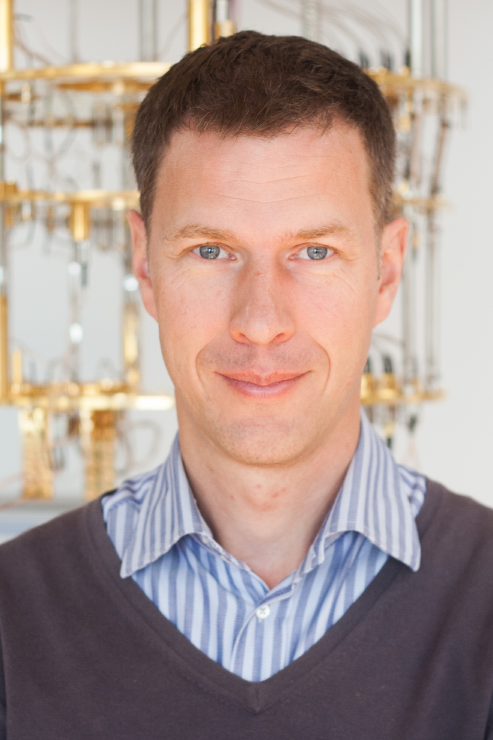Q&A: Lieven Vandersypen, Quantum Nanoscientist
by Jerwin De Graaf
Lieven Vandersypen of the Kavli Institute of Nanoscience talks about the QuTech, its quantum computing partnership with Intel and industry.

The Author
The Researcher
Lieven Vandersypen, co-director of the Kavli Institute of Nanoscience, was the driving force behind a $50-million partnership between Intel and Qutech, a quantum-computing research center affiliated with TU Delft, announced last year. In this Q&A, he talks about what the partnership might achieve, the future of the Kavli Institute and his new role as its co-director.
This interview has been adapted from an article published by the Kavli Institute for Nanoscience Delft in November, 2016.
Can you tell us something about yourself?

Certainly. I am married with two daughters and a son on the way. I play squash, but have had less time for other hobbies since the children arrived. I also co-founded a classical choir in which I sometimes sing bass. Apart from that, I enjoy water sports such as windsurfing and kite surfing, although recently only during the holidays. Having invested in new equipment, I plan to start kite surfing again in Scheveningen or Kijkduin [on the North Sea, near The Hague] soon.
How did your professional career start?
After studying mechanical engineering in Belgium, I did a Master's and Ph.D. in Electrical Engineering at Stanford University. I researched quantum computing with NMR [nuclear magnetic resonance spectroscopy], using the spin of atoms in molecules as quantum bits.
What triggered the move to quantum computing?
It started with an interest in small-scale mechanics. In the mid 1990s, I saw the first images of tiny mirrors on a chip flapping backwards and forwards, and small rotors rotating. It's called micro-machining and it interested me immensely. Since I was also captivated by quantum mechanics, I started to think about looking at the quantum aspects within these moving mechanical objects. But then I came into contact with Ike Chuang, who became my Ph.D. supervisor and told me about quantum computers. I immediately immersed myself in the subject, often being so fascinated that I could hardly sleep.
"I think that it [the Kavli Institute for Nanoscience] exemplifies the best science in our field. We allow ourselves to be driven by what excites us, which is why we continue to innovate."—Lieven Vandersypen
And next you came to Delft?
Yes. I had been thinking about what approach to quantum computing I wanted to research for my post-doc. I eventually decided to work on electron spins in semi-conductor quantum dots. Leo Kouwenhoven's group in Delft was one of the best groups in that field. At a conference, I asked him why he had not tried quantum computing with his quantum dots [tiny semiconductor particles]. It turned out that he had only just taken an interest in it and had secured funding. He was able to take me on as a post-doc.
Are you still interested in developing a quantum computer?
Definitely. After joining TU Delft as a tenure track Assistant Professor, I started my own group in 2003 and we were able to make major advances in research. In the beginning, the main question was whether developing a quantum computer was even possible. The answer remains uncertain, but there is definitely greater confidence now. We have taken major steps in the past years, both theoretically and in our experiments that have made me optimistic.
Is it true that here is also increasing involvement from the industry?
Yes. Apart from fundamental physics, we now also find ourselves confronted with more and more technological hurdles. That was partly the reason for setting up QuTech, in which we are collaborating with engineers from TNO [Netherlands Organisation for Applied Scientific Research] and from the university. We started a major partnership with Intel just a year ago. It's very unusual for us, but also for them, because they are making available their people and facilities for our research.
How will working with Intel contribute to the quantum computer?
We aim to create larger numbers of uniform quantum bits. Currently, qubits have personalities, which is something we need to move away from, as these personalities are difficult to deal with. If you want to work with larger numbers of quantum bits – and we are talking dozens rather than thousands – it requires an important improvement in the uniformity and reliability of the processes you use to make them. We are working actively in partnership to achieve that.

How do you view your role as co-director?
The way I see it, each of the two co-directors represents the entire institute. I am not here to represent the quantum scientists, I am a co-director for everyone. Just like [the Institute's director ]Cees Dekker, and [founding director] Hans Mooij before him. Next, we have now invited QuTech group leaders from outside the Quantum Nanoscience and Bionanoscience (BN) departments to also become part of Kavli and most of them have already agreed to do so. I intend to see to a successful integration, by organising opportunities to meet each other, for example. With the BN department moving to another building, there is also a risk of the departments drifting apart. My explicit aim is to keep the two groups together, for instance by encouraging joint research projects.
What is Kavli's strength, in your view?
I think that it exemplifies the best science in our field. We allow ourselves to be driven by what excites us, which is why we continue to innovate. We are the first Kavli Institute to have been established outside the US and one of five specialising in nanosciences. The others are Harvard, Cornell, Berkeley and Caltech, so we are certainly in good company. I think we are successful in identifying promising new directions. We are also not afraid to pursue completely different paths, such as the partnership with Intel. That was almost unthinkable five years ago, as we were not quite ready for it mentally. But when the field starts moving in such a direction, you want to identify opportunities and seize them. The major joint programmes we have set up with Leiden, such as NanoFront and the Casimir Research School are also great initiatives. Together with Kavli, they have created a strong and dynamic nanoscience community. Finally, we have succeeded in attracting some outstanding tenure track staff to TU Delft in recent years, both in bio and in quantum.’
What else do you hope to achieve?
I think there is potential for further strengthening the mutual bonds within the institute. At the Kavli faculty meeting in the summer, we brainstormed about the overlaps between bio and quantum, and there are plenty. Based on these, we intend to establish more joint research projects. As Kavli directors, it is our job to encourage that. It starts by becoming better acquainted with each other, and accordingly I plan to visit all my bio colleagues to get updated on their research. This will increase our knowledge and understanding of what others are doing and have to offer and, of course, how it can be linked to one’s own research. We are already doing a lot in this area, but I aim to stimulate this so that the Institute can get more out of it.
How do you envisage the period ahead for the Kavli Institute of Nanoscience?
We intend to set up various new activities. For example, we want to establish a prestigious visiting professor programme, inviting the most prominent nanoscientists in the world to spend several months in Delft. We also have plans to set up a new post-doc programme with Kavli Postdoc Fellows. Another idea is to have an artist or writer in residence, with a view to initiating a creative exchange of ideas. We would also like to engage in more outreach and offer strategic support for the Kavli Nanolab Cleanroom. By that I mean investing at the right time, when you can really make a difference. We hope to secure an additional contribution from the Kavli Foundation to help make these plans possible.
What else do you envisage for the future?
The Kavli Institute has now been in existence for 12 years and it has always had an exceptionally positive reputation. I can only see that growing still further. In ten years' time, Kavli will be a more active community. It will also be bigger, both as a result of the reinforcement from QuTech and the fact that the two departments continue to attract new staff. My genuine hope is for the institute to look completely different in ten years' time, but in a way that is impossible to predict at this stage. If it does, it would mean that we have remained dynamic, and that we have continued to explore and develop new initiatives.